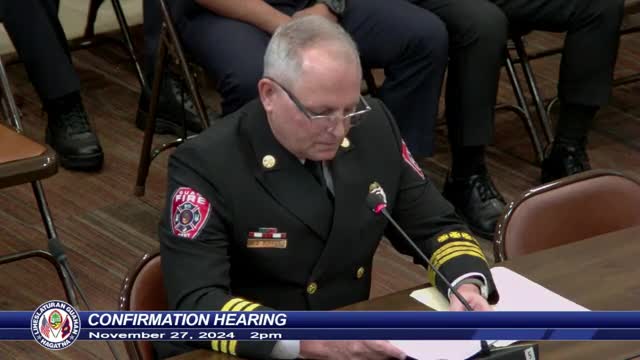Fire Chief outlines ambitious plans to transform emergency services
November 01, 2024 | Fire, Agriculture, Power and Energy Utilities, Public Transit, Unemployment Insurance and Universal Health Care Insurance , Legislative, Guam
This article was created by AI summarizing key points discussed. AI makes mistakes, so for full details and context, please refer to the video of the full meeting. Please report any errors so we can fix them. Report an error »

In a recent government meeting, the Guam Fire Department's leadership outlined a comprehensive plan for enhancing emergency services and addressing staffing challenges. The discussion was led by a senior official with over three decades of experience in the department, who emphasized the importance of teamwork and legacy in shaping the current fire service.
The official highlighted the department's evolution, particularly noting the establishment of the first advanced life support unit, which marked a significant advancement in life-saving services. This initiative, along with the department's commitment to professional development, has positioned Guam as a regional leader in fire services, achieving national certifications for its firefighters.
Key short-term goals were presented, including the urgent need to reinforce the emergency medical response fleet. Currently, the department operates eight ambulances, with five already in service and a sixth expected to return to operation shortly. Plans are underway to procure four new ambulances, with an anticipated six-month timeline for their deployment.
Staffing remains a critical issue, with the department currently training 33 recruits expected to graduate in March 2025. The official acknowledged the need for additional recruitment cycles to meet the required staffing level of 314 firefighters, as the department currently has around 230 personnel. This recruitment effort aims to alleviate overtime demands and reduce stress on existing staff.
Long-term objectives include the construction of a new fire station in Synehania to improve response times in Central Guam, as well as a rescue base in Tumon. The department is also focused on enhancing leadership development programs to prepare firefighters for future leadership roles and ensure continuity in operations.
Additionally, there are plans to expand community response capabilities through a mobile integrated healthcare system, which will incorporate a community paramedic program aimed at improving overall public health and emergency response.
The meeting underscored the department's commitment to continuous improvement and the importance of investing in both personnel and infrastructure to meet the challenges of the future.
The official highlighted the department's evolution, particularly noting the establishment of the first advanced life support unit, which marked a significant advancement in life-saving services. This initiative, along with the department's commitment to professional development, has positioned Guam as a regional leader in fire services, achieving national certifications for its firefighters.
Key short-term goals were presented, including the urgent need to reinforce the emergency medical response fleet. Currently, the department operates eight ambulances, with five already in service and a sixth expected to return to operation shortly. Plans are underway to procure four new ambulances, with an anticipated six-month timeline for their deployment.
Staffing remains a critical issue, with the department currently training 33 recruits expected to graduate in March 2025. The official acknowledged the need for additional recruitment cycles to meet the required staffing level of 314 firefighters, as the department currently has around 230 personnel. This recruitment effort aims to alleviate overtime demands and reduce stress on existing staff.
Long-term objectives include the construction of a new fire station in Synehania to improve response times in Central Guam, as well as a rescue base in Tumon. The department is also focused on enhancing leadership development programs to prepare firefighters for future leadership roles and ensure continuity in operations.
Additionally, there are plans to expand community response capabilities through a mobile integrated healthcare system, which will incorporate a community paramedic program aimed at improving overall public health and emergency response.
The meeting underscored the department's commitment to continuous improvement and the importance of investing in both personnel and infrastructure to meet the challenges of the future.
View full meeting
This article is based on a recent meeting—watch the full video and explore the complete transcript for deeper insights into the discussion.
View full meeting